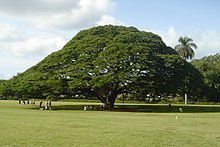| Samanea saman | |
|---|---|

| |
| The Hitachi Tree at the Moanalua Gardens, Hawaii | |
| Scientific classification | |
| Kingdom: | Plantae |
| Clade: | Tracheophytes |
| Clade: | Angiosperms |
| Clade: | Eudicots |
| Clade: | Rosids |
| Order: | Fabales |
| Family: | Fabaceae |
| Subfamily: | Caesalpinioideae |
| Clade: | Mimosoid clade |
| Genus: | Samanea |
| Species: | S. saman
|
| Binomial name | |
| Samanea saman | |
| Synonyms[3] | |
|
List
| |

Samanea saman is a species of flowering tree in the pea family, Fabaceae, now in the Mimosoid clade[5] and is native to Central and South America.[6] It is often placed in the genus Samanea,[7] which by yet other authors is subsumed in Albizia entirely.
Its range extends from Mexico south to Peru and Brazil, but it has been widely introduced to South[citation needed] and Southeast Asia, as well as the Pacific Islands, including Hawaii. It is a well-known tree, rivaled perhaps only by lebbeck and pink siris among its genus. It is well represented in many languages and has numerous local names in its native range;[8] common English names include saman, rain tree and monkeypod[6] (see also § Names below).
In Cambodia it is colloquially known as the Chankiri Tree (can be written ចន្ទគិរី or ចន្ទ៍គីរី).
- ^ Botanic Gardens Conservation International (BGCI) & IUCN SSC Global Tree Specialist Group. 2019. Samanea saman. The IUCN Red List of Threatened Species 2019: e.T144255307A148988354. https://dx.doi.org/10.2305/IUCN.UK.2019-2.RLTS.T144255307A148988354.en. Accessed on 01 March 2024.
- ^ "Albizia saman. NatureServe Explorer 2.0". explorer.natureserve.org. Retrieved 1 March 2024.
- ^ a b "Samanea saman (Jacq.) Merr". Plants of the World Online. Royal Botanic Gardens, Kew. Retrieved 3 March 2020.
- ^ Merrill, E.D. (1916). Journal of the Washington Academy of Sciences. 6: 47.
{{cite journal}}: Missing or empty|title=(help) - ^ The Legume Phylogeny Working Group (LPWG) (2017). "A new subfamily classification of the Leguminosae based on a taxonomically comprehensive phylogeny". Taxon. 66 (1): 44–77. doi:10.12705/661.3. hdl:10568/90658.
- ^ a b Staples, George W.; Elevitch, Craig R. (2006). "Samanea saman (rain tree)". In Elevitch, Craig R. (ed.). Traditional Trees of Pacific Islands: Their Culture, Environment, and Use. Holualoa, Hawaii, USA: Permanent Agricultural Resources. pp. 662–664. ISBN 978-0-9702544-5-0.
- ^ "Samanea saman". Germplasm Resources Information Network. Agricultural Research Service, United States Department of Agriculture. Retrieved 2010-03-25.
- ^ Cite error: The named reference
humboldt99was invoked but never defined (see the help page).

